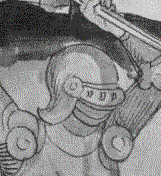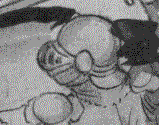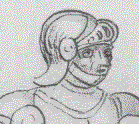Also, any ideas as to whether there is a horizontal eyeslot above the visor, or if it's only the vertical ones? One picture appears to only have the vertical slots, one looks like it may possibly have the horizontal one as well.






| Brian W. Rainey wrote: |
| To my knowledge, that style of helm only exists in literature/art. |
| Bill Grandy wrote: | ||
Hi Brian, That's very interesting. Out of curiosity, is there a reason you say it only exists in literature/art as opposed to saying we just don't have any surviving samples? Is there something about the helmet that makes it unrealistic? |
| Nathan Robinson wrote: |
| Brian, I'm glad you posted that, as I was wondering why I was having such difficulty finding an example. |
| Brian W. Rainey wrote: |
|
One thing to keep in mind is that the reference is a manual for sword play, not armour... so there was probably more attention paid to other aspects, from the artists perspective. |